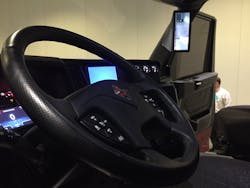Still haven’t moved to ELDs? Here’s what to expect when you do
By Pete Allen, MiX Telematics
Back on December 18, the now-infamous electronic logging device (ELD) mandate went into effect and though we’re in a period of “soft enforcement” right now, that doesn’t mean drivers and fleets won’t be issued citations for noncompliance with this new regulation. In this guest column, Pete Allen, chief client officer at MiX Telematics, offers advice for “late adopters” of ELDs, especially what areas will be key to focus on as the devices get deployed.
An October 2017 survey conducted by C.J. Driscoll & Associates found that 60% of for-hire fleets had yet to switch from paper logs to ELDs. Among private fleets, the number was zero.
Since the process can be lengthy, those results indicate many fleets probably didn’t make the Federal Motor Carrier Safety Administration (FMCSA) deadline of December 18 for ELD implementation.
The FMCSA and Commercial Vehicle Safety Administration (CVSA) previously noted that commercial vehicles won’t be placed out of service for non-compliance with the ELD rule until April 1 this year and that non-compliance will not affect CSA [Comprehensive, Safety, Accountability] scores – at least in the short term.
But most truckers should know that “grace period” ultimately means they need to get started on an ELD transition right away. Below, we’ll focus on what we at MiX Telematics has learned in the dozens of ELD implementations we’ve already been a part of – sharing best practices that may make your transition easier.
Understand the grandfather clause details: If you are currently using automatic onboard recording devices (AOBRDs) to electronically track hours of service (HOS) information, you are grandfathered-in and don’t have to move to true ELDs until December 2019. While you can transfer existing AOBRDs to replacement vehicles, any “net-new” vehicles added to your fleet must have ELDs installed. Many fleets we’ve talked with didn’t know about the “net-new” rule.Decide on a phased approach versus all at once: If your fleet has one domicile, it’s relatively simple to switch over all vehicles to ELDs all at once. If your fleet has multiple domiciles, we recommend a “phased” approach, installing ELDs at one domicile at a time. If you are grandfathered-in and have multiple domiciles, you’re in luck – you can spread your ELD implementation out over time to allow for proper planning and training of drivers and administrators.
You can’t have too much training: Regardless of what ELD vendor you use, they should provide training tools to support your ELD transition. Training staff are likely to be spread thin over the next six months as many fleets scramble to comply, so book your training early. For some fleets, online training may provide a better, less time-consuming training option. Online training will allow your employees to go at their own pace; even repeat training sections as necessary.
Drivers “own” their ELD logs: Driver training should highlight the differences between AOBRDs (if you currently have them) and ELDs, or paper logs and ELDs. The biggest change for drivers in both cases is that with ELDs, drivers own responsibility for HOS logs. Administrators can edit the electronic log, but drivers have final say over accepting those edits. Every time a driver logs on to their ELD, they will need to review and confirm:
- Their HOS log for the past 24 hours.
- Any edits to their HOS log that someone else has made.
- Unidentified mileage (which must then be assigned).
Training needs to address all three of these things, including procedures. For instance, what a driver should do if he/she isn’t sure how to assign mileage, or doesn’t agree with an edit someone has made to their log?
Drivers need training on how to handle roadside inspections: Your ELD system will likely offer one or both of these options for sharing ELD data with inspectors: 1) remote file transfer via email or wireless transfer, or 2) local file transfer via USB or Bluetooth. Make sure drivers know how to do this, and practice it in a classroom before they have to do on the side of the road.
Essential training for administrators: Again, the biggest change for administrators is that in an ELD world, they no longer own HOS logs – drivers have the final say. Administrators should plan on reviewing HOS, edits and unidentified mileage daily to make sure missing or incomplete data doesn’t get out of hand. Most ELD solutions have an audit trail in place – this feature is crucial as it will help administrators track down and fix any issues. Once everyone gets used to the new ELD system, administrators may be able to back down to reviewing HOS weekly, but we recommend making daily review of edits and unidentified mileage a long-term habit. Think of this like reconciling your bank account – if you get behind by a few months, it gets very difficult to track down discrepancies.
Have a policy in place for who is responsible for making edits: Sometimes, HOS logs need to be edited. For example, consider a common scenario where a driver forgets to go off duty during a stop for a meal or even overnight. Fleets should have a policy in place for who is responsible for making edits to HOS logs. Some fleets have decided that administrators are responsible for edits, although drivers still have final say to accept or reject them. Other fleets have decided that since drivers own the logs, they must do their own editing. Our recommendation: make fleet administrators responsible for making HOS edits, and have drivers accept or reject them. Administrators will do this more consistently, with fewer mistakes, because they will do it more often.
If there is one advantage to being late in your transition to ELDs, it is the ability to learn from the mistakes of others. So take this advice to heart as you move forward.

